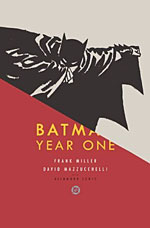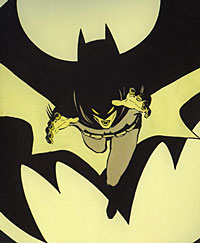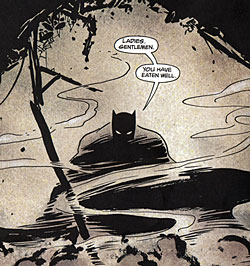>> The Friday Review: The Losers: Ante Up
>> The Friday Review: Marvels
More...

 Writer: Frank Miller
Writer: Frank Miller
Artist: David Mazzuchelli
Colourist: Richmond Lewis
Letterer: Todd Klein
Collecting BATMAN #404-407
Price: $19.95 (hardcover)
Publisher: DC
ISBN: 1401206905
There's a certain subset of internet superhero comics fandom that subscribes to the theory that Batman Always Wins. He is always prepared, with his utility belt and Sci-Fi Closet stocked for any possible eventuality. He can out-think, out-fight and out-manoeuvre any given character in the DC universe. He's rich; he has a trained squad of dedicated fellow soldiers fighting alongside him; and on top of all that, he has known the charms of several beautiful women, from shallow socialites to thieves and zealots.
To which I say: bollocks.
If I were to list the counter-arguments to that notion this wouldn't be a review, just a screed of trivia and personal opinion that would better suited to a blog. The only evidence I really need to cite is present in the pages of just one book: BATMAN: YEAR ONE.
While it's true that the way Batman has been portrayed in recent years requires a great deal more suspension of disbelief than usual (near-omniscience, extreme paranoia), admittedly it's not entirely inconsistent with previous iterations of the character (at least going back as far as the 70s). Frank Miller, as is his wont, played up certain aspects of Batman that best served his story in THE DARK KNIGHT RETURNS, and he references those same aspects here - while at the same time scaling them back - as fits the nature of the story - and making Bruce Wayne more human (if not humane).
 YEAR ONE and DARK KNIGHT RETURNS tacitly and intentionally mirror each other in several respects - bookending the myth, as it were - and yet for all its grit and rust-metal tang, YEAR ONE contains at its heart the optimism and hope that are expected of new beginnings and fresh starts. Bruce Wayne isn't the only one starting over, either - the bulk of the narrative is given over to James Gordon, who has moved from Chicago to serve with the GCPD as a lieutenant.
YEAR ONE and DARK KNIGHT RETURNS tacitly and intentionally mirror each other in several respects - bookending the myth, as it were - and yet for all its grit and rust-metal tang, YEAR ONE contains at its heart the optimism and hope that are expected of new beginnings and fresh starts. Bruce Wayne isn't the only one starting over, either - the bulk of the narrative is given over to James Gordon, who has moved from Chicago to serve with the GCPD as a lieutenant.
Prefiguring Miller's own SIN CITY by a few years, the author's vision of Gotham is a veritable cesspool of corruption, with crooked cops and underhanded politicians proving to be as much of a problem as the criminal element. In truth, it's not perps and pushers that prove to be Gordon's initial hurdle; it's his own immediate superiors. Gordon's first infraction against his fellow police officers demonstrates what's required of a good cop in a bad town - a lesson that nascent vigilante Bruce Wayne is slow to learn: in Gotham, respect is earned through fear.
While Gordon has some measure of security and facility in his public role as part of the thin blue line, Wayne has no such position to fall back on - until chance provides him with means and method to carry out his crusade. The next time we see Wayne, he's sporting the familiar cape and cowl - and making a mess of rousting some young punks in the midst of breaking and entering. It's not exactly the most auspicious of starts.
Of course, both beleaguered police lieutenant and new-to-the-role caped crusader are working towards the same goal from opposite ends. At first this leads to conflict, then realisation - slow, but eventual - that they're on the same side. This is the crux of YEAR ONE: how two such people become comrades-in arms, united in a common cause.
YEAR ONE is textbook Miller; noir backdrops, hard-boiled dialogue, well-staged action, flawed men, seductive women. Running at less than a hundred pages, the plot is taut, with no room for wasted moments. The story ends abruptly, with the odd loose end, but YEAR ONE is merely a gazetteer - a sampler, if you like - of the Dark Knight's first few tentative months.
 Naturally, YEAR ONE has had two sequels and several imitators. Its story has been further fleshed out by Loeb and Sale's retro projects, and there has been a multitude of similar arcs presented in the pages of LEGENDS OF THE DARK KNIGHT. To all intents and purposes, however, this is the true origin story of the Bat.
Naturally, YEAR ONE has had two sequels and several imitators. Its story has been further fleshed out by Loeb and Sale's retro projects, and there has been a multitude of similar arcs presented in the pages of LEGENDS OF THE DARK KNIGHT. To all intents and purposes, however, this is the true origin story of the Bat.
David Mazzuchelli is Miller's artist here, as he was on DAREDEVIL: BORN AGAIN, and while the former project required a more dynamic art style (dare I say, closer to the Mighty Marvel Manner); here Mazzuchelli is more relaxed, even sedate.
There's a distinctly minimalist, European feel to the storytelling, with echoes of Hugo Pratt, coupled with the iconography inherent in depicting a modern Dark Knight. Richmond Lewis' colouring eschews the gaudy pop art splashes expected of 80s comics, instead opting for muted schemes, often variations on the one shade. Her work complements Mazzuchelli's well, allowing his linework to breathe, instead of crushing it with 'look-at-me' razzle-dazzle.
The handsome new hardcover edition of YEAR ONE features some terrific extras, including unseen art and a glimpse of the original pencils, samples of Miller's script, and a new illustrated afterword by Mazzuchelli.
Batman doesn't always win - what a boring protagonist he'd be if he did. YEAR ONE reminds us that he's a character motivated by what he's lost, and it's in losing that he becomes a character at all. A lot of creators seem to forget that these days. The trend is to depict him as a relentless, grim monomaniac. Yet the reason that Batman has endured all these decades is that, of all DC's pantheon, he is the most human. He's always prepared to win -but he knows what it means to lose.

This article is Ideological Freeware. The author grants permission for its reproduction and redistribution by private individuals on condition that the author and source of the article are clearly shown, no charge is made, and the whole article is reproduced intact, including this notice.


